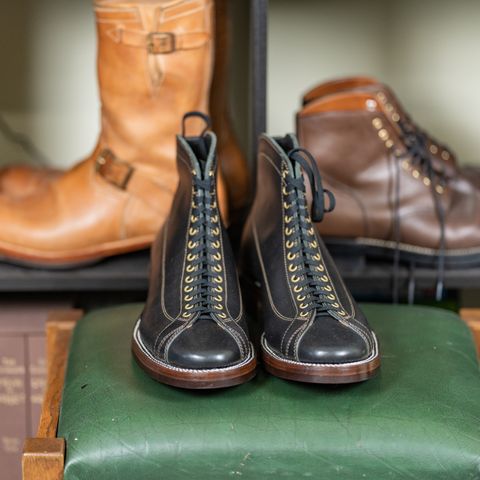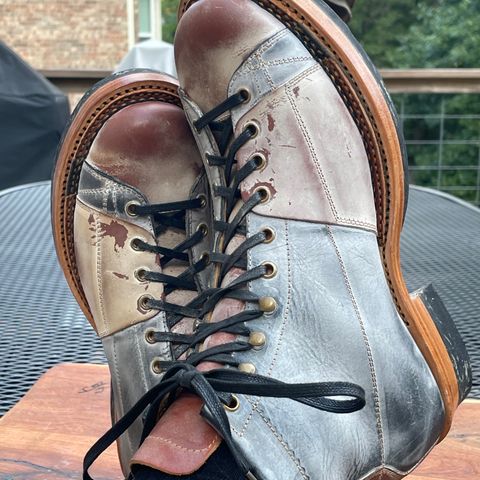About
Nero Minerva is a black colorway of Minerva vegetable-tanned vacchetta leather produced by Badalassi Carlo tannery in Tuscany, Italy. The name "nero" means black in Italian, representing the darkest color option in the Minerva line. The leather combines the classic Minerva characteristics of fat-liquored vacchetta construction with a deep black aniline dye that penetrates throughout the material, creating full color saturation while maintaining the natural grain visibility characteristic of vegetable-tanned leather.
About
Nero Minerva is a black colorway of Minerva vegetable-tanned vacchetta leather produced by Badalassi Carlo tannery in Tuscany, Italy. The name "nero" means black in Italian, representing the darkest color option in the Minerva line. The leather combines the classic Minerva characteristics of fat-liquored vacchetta construction with a deep black aniline dye that penetrates throughout the material, creating full color saturation while maintaining the natural grain visibility characteristic of vegetable-tanned leather.
Nero Minerva is available in both the smooth (Liscio) and pebbled (Box) variants that define the Minerva collection. The black colorway develops a distinctive patina through use, where friction and oils create a lustrous buffed finish rather than dramatic color changes. Heritage footwear manufacturers and leather goods makers utilize Nero Minerva for products requiring both structural durability and the refined aesthetic of black vegetable-tanned leather.
Characteristics and variants
Nero Minerva shares the fundamental characteristics of the Minerva leather type while offering distinct aging properties specific to black vegetable-tanned leather.
Physical specifications
The leather is produced as full-grain material with visible depth and coloring in the smooth grain surface. Nero Minerva is typically available in 5 ounce thickness, measuring approximately 2mm with a tolerance of ±0.2mm. The material maintains the firm and structured construction characteristic of Minerva leather, while remaining highly workable for cutting and skiving operations. The smooth variant features a matte texture achieved through light wax coating application, while the texture and construction provide durability and resistance to wear and tear.
Variants and applications
Nero Minerva is produced in two surface finish options that maintain the same black color while offering different textures. The smooth variant features the classic Minerva Liscio finish with a matte black surface and smooth grain. The pebbled variant, marketed as Minerva Box, presents a naturally tumbled texture created through dry milling processes rather than artificial embossing.
Both variants are suitable for leather goods including bookbinding, cases, clutches, handbags, shoes, small leather goods, wallets, watch straps, and tote bags. The leather also finds application in leather bags, briefcases, and items requiring structural integrity and durability. John Lofgren manufactures Steel Gang SW Boots in Badalassi Carlo Black priced at $1,250 USD, representing the leather's positioning in premium heritage footwear.
Patina development
Black vegetable-tanned leather exhibits distinctive aging characteristics that differ from lighter colored Minerva variants. Rather than developing dramatic color changes, Nero Minerva's patina manifests through surface burnishing and shine development.
Burnishing properties
The high fat content in Minerva leather accentuates changes with prolonged use and friction. When rubbed, the black surface becomes increasingly shiny and lustrous, exhibiting burnishable properties where usage and time enhance the leather's appearance. This burnishing effect creates a polished patina in areas subjected to frequent contact, resulting in a glossier finish in high-wear zones while maintaining a matte appearance in less-handled areas.
Surface characteristics
The natural patina development follows a pattern more akin to buffing than traditional darkening. Oils from handling combine with friction to buff the top layer, creating a smoother and shinier surface finish. The vegetable tanning process and fat-liquoring treatment allow the leather to develop this lustrous shine naturally without requiring additional conditioning or polishing treatments. Surface scratches often rub out rather than leaving permanent marks, as the material shrugs off minor surface damage through normal use.
Production and tanning
Nero Minerva follows the traditional Badalassi Carlo production methods that define all Minerva leather variants, with the black coloration achieved through aniline dyeing processes.
Tanning methods
The tannery employs traditional vegetable tanning methods using tree barks, following processes that have spanned centuries. As a member of the Pelle Vegetale Consortium, Badalassi Carlo adheres to strict traditional vegetable tanning standards certified by the consortium established in 1994. The consortium includes 19 member tanneries operating in Tuscany between Pisa and Florence, each following verified traditional methods.
Minerva is classified as a vacchetta leather type, distinguished by a special blend of Italian fat wax infused into the material during production. This fat-liquoring process creates the characteristic soft hand feel and depth that allows for patina development. The production combines ancient recipes with modern technology while requiring time and patience in the tanning process.
Color application
The black coloration is achieved through aniline dye that penetrates throughout the leather thickness, creating full color saturation from surface to flesh side. This through-dye process ensures consistent black coloring even when the leather is cut or edged, unlike surface-dyed materials where the core leather remains a different color. The aniline dyeing maintains transparency that allows the natural grain pattern to remain visible, preserving the character of the full-grain leather surface rather than obscuring it with opaque pigments.
References
"Badalassi Carlo - Minerva Smooth - 'Vacchetta' Veg Tanned Leather". Rocky Mountain Leather Supply. Retrieved October 30, 2025.
"Badalassi Carlo Minerva Collection". A & A Crack & Sons. Retrieved October 30, 2025.
"John Lofgren Badalassi Carlo Vegetable Tanned Leather Collection". John Lofgren. Retrieved October 30, 2025.











































